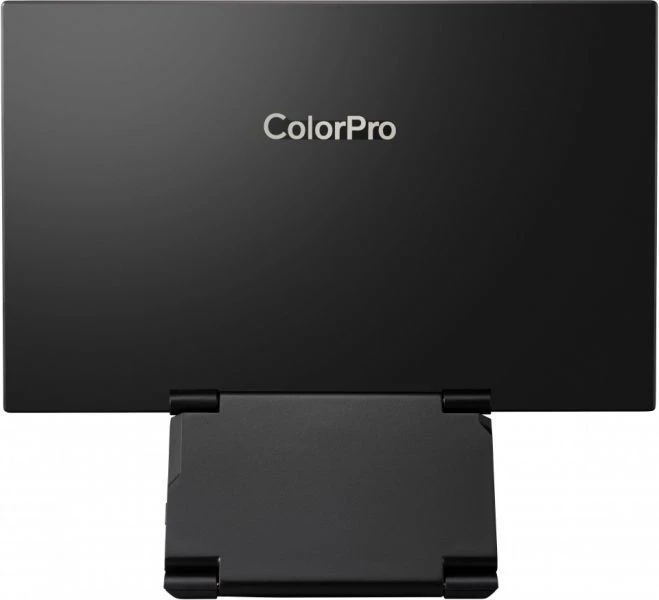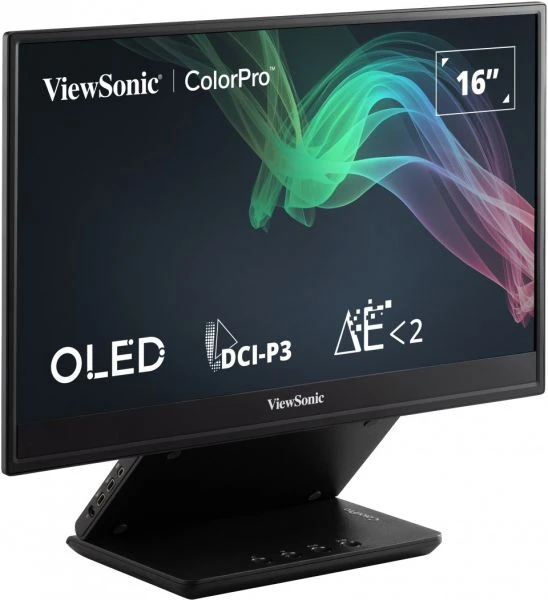Traveling with a high-quality monitor has never been easier. The Viewsonic ColorPro VP16-OLED is an excellent portable monitor for on-the-go use, boasting a superb OLED panel and a versatile, ergonomic stand.
Pros
- Versatile stand
- Good connectivity options
- Cables included in the package
- Numerous options for image quality customization
- First-rate image quality even at standard settings
Cons
- Speakers included but of weak quality
- Pricey for a portable monitor
- No HDR
As an Amazon Associate, I earn from qualifying purchases.
Portable monitors are a popular option for travellers and those with limited desk space. However, most portable monitors come with a simple kickstand offering limited adjustability. The VP16-OLED from Viewsonic improves this with a versatile stand that enables various desk positions. The highlight is the monitor’s high-quality OLED panel.
Design & Build
Viewsonic has opted for a simple, professional design for the ColorPro VP16-OLED. A kind of lip surrounds the display, providing protection. The manufacturer has not chosen a continuous glass look but notes the OLED panel is fragile and should be handled with care, especially when travelling.
The Viewsonic ColorPro VP16-OLED folds flat, making it extremely portable.
The VP16-OLED features an integrated stand that folds behind the display. It can be used as a kickstand or extended into a stand that raises the monitor about 10 centimeters above the desk. This is a significant advantage over portable monitors with simple stands, offering more ergonomics and requiring less desk space.
The versatile stand, however, is heavier. The total weight of the monitor at 2.2 kilograms is quite high for a portable monitor: most weigh less than 1.3 kilograms, some even less than 1 kilogram.
You won’t find a VESA mount for using third-party VESA stands, a common feature for most portable monitors. However, the VP16-OLED does have a tripod mount hidden at the back of the stand. The package also includes a glare shield to reduce the glare of the glossy screen.
The Viewsonic ColorPro VP16-OLED may seem expensive at first glance. With a list price of €399.99, it is significantly more expensive than the popular portable monitors on Amazon starting at €110.
However, the Viewsonic is competitive with the Asus Zenscreen MQ16AH, a very similar monitor. The monitors from Viewsonic and Asus are comparable in most aspects, including resolution and refresh rate. Viewsonic offers practical features interesting for professional users.
What really sets the VP16-OLED apart are the extras: a versatile stand, a glare shield, and a tripod mount, providing tremendous added value to an already impressive display.

Features & Menus
The stand of the VP16-OLED also houses the connections, offering another advantage over the typical kickstand. The ports are easier to find and connect, as they can be accessed without moving the entire screen.
The Viewsonic ColorPro VP16-OLED monitor has all the connections you could wish for.
The connections include two USB-C ports, each supporting DisplayPort Alternate Mode and a power input of up to 40 watts. The monitor has a maximum power consumption of 15 watts, so most USB-C power sources are sufficient.
The monitor also features a Micro-HDMI 1.4 port and a 3.5 mm audio output. Note that the Micro-HDMI 1.4 port does not provide power, so an additional USB-C power source is required for this video input.
Viewsonic supplies the monitor with a USB-C power adapter and three cables: USB-C to USB-C, USB-A to USB-C, and HDMI to Micro-HDMI 1.4. Everything needed to operate the monitor is in the box.
The menu control on the Viewsonic ColorPro VP16-OLED screen is located on the stand. It works well, although navigating the menu can be a bit cumbersome due to the arrangement of the arrow keys.
The monitor has presets for DCI-P3, sRGB, REC709, and DICOM-SIM. Hidden deeper in the menus are additional controls for gamma and color temperature adjustments. These are managed by preset, making it easy to tailor the various options to your preferences or needs.
The monitor includes speakers. The volume is quiet but clear enough for a quick check of audio levels when editing video or audio content. Podcasts and YouTube videos also sound good.
SDR Image Quality
Most portable monitors offer image quality sufficient for Word documents and internet browsing. For the ColorPro VP16-OLED, expectations for image quality are higher due to the price and target audience. The monitor meets and even exceeds these expectations.
A quick note on the comparison results: The monitors compared below are not direct competitors to the VP16-OLED but represent a range of panel technologies found in competing monitors.
The Viewsonic VP16-OLED starts with a high brightness of up to 375 Nits. This is excellent for a standalone OLED monitor, comfortably beating the QD-OLED panel of the Alienware AW3423DWF and lining up alongside conventional IPS displays like the Gigabyte M27Q X and the NZXT Canvas 27Q. The high-end OLED display Asus ProArt PG32DC wins with 540 Nits.
Unsurprisingly, the VP16-OLED exhibits an excellent contrast ratio that exceeds the sensitivity of the colorimeter used for testing. There are technical contrast differences between OLED monitors, but these are hard to discern.
You will notice the enormous advantage of the VP16-OLED over an IPS display like those from Gigabyte and NZXT. The OLED appears darker and richer in dark scenes, yet has more depth in bright content. This is the reason for excellent results in gaming, movies, and professional applications.
With a color space covering the entire sRGB and DCI-P3 gamut and 97 percent of the AdobeRGB gamut, the VP16-OLED goes far beyond the norm. It outperforms both the Alienware AW3423DWF, which features a QD-OLED panel from Samsung, and the Gigabyte M27Q X, which integrates an IPS display with Quantum Dots.
Such a large color gamut is suitable for almost anything: photo and video editing, digital art, and animation. As mentioned, the monitor features several preset modes that can further tailor the color gamut to specific standards. These are useful if you work in a smaller color space like sRGB and want to ensure accurate color representation.
Speaking of accuracy: The VP16-OLED performs quite well, even though it lags behind the competition in standard settings in this area. Other portable monitors may deliver better results out of the box. However, it’s fair to say that this color accuracy is sufficient to provide a realistic, lifelike image.
The standard settings of the VP16-OLED offer a color temperature of 6,200K, which is slightly warmer than the target value of 6,500K. This means the image appears more red and pink. The standard gamma is set at 2.3, slightly above the target value of 2.2. Content appears a bit darker than it should.
However, the monitor’s menus offer an impressive selection of gamma and color temperature modes that matched the target values in my tests. This means you can adjust the image to any color temperature or gamma setting you need for your work or that your eyes prefer.
The sharpness is outstanding. The monitor’s 1080p resolution may not seem high on paper, but it corresponds to a pixel density of 141 pixels per inch. This is between the pixel density of a 27-inch 1440p monitor and a 27-inch 4K monitor. Content appears crisp, and small fonts smooth.
Overall, the image quality of the Viewsonic ColorPro VP16-OLED is excellent. It performs very well in most measurements. The color space is its strongest feature and delivers results not found in any other monitor. The vivid and strong display of the VP16-OLED will appeal to office users. Its color performance and numerous image quality options meet the demands of content creators.

HDR
Viewsonic does not offer HDR support with the ColorPro VP16-OLED. This may shock, as many cheaper portable monitors support HDR. However, the HDR performance of most monitors in this category is rather modest, so the lack of HDR support is less surprising than it might seem.
Nevertheless, some professional users will be disappointed. Those who want HDR should consider the Asus Zenscreen MQ16AH.
Motion Representation
The Viewsonic ColorPro VP16-OLED lacks features to enhance motion performance. It has a refresh rate of 60 Hz and does not have Adaptive Sync.
The Viewsonic ColorPro VP16-OLED offers excellent image quality for such a compact design.
However, OLEDs offer a certain advantage in motion sharpness due to their excellent pixel response times. The ColorPro VP16-OLED claims a grey-to-grey response time of one millisecond, comparable to many gaming monitors. This contributes to reducing motion blur. The motion sharpness is less than 120 Hz or 144 Hz monitors, but higher than most (if not all) 60Hz IPS monitors.
Conclusion
The Viewsonic ColorPro VP16-OLED is a fantastic mobile monitor. It delivers stunning image quality with solid brightness, excellent contrast, and an extremely large color gamut. What really sets the VP16-OLED apart are its extras. The monitor features a versatile stand, a glare shield, and a tripod mount for use on the go.
Also included in the package are all the cables and power supplies needed to operate the display with USB-C, USB-A, or HDMI output.
With a list price of €399.99, the ColorPro VP16-OLED is somewhat expensive, but not more so than other portable OLED monitors. Its many advantages make it a recommendable device.
As an Amazon Associate, I earn from qualifying purchases.
